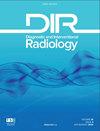Magnetic resonance imaging of benign prostatic hyperplasia.
IF 2.1
4区 医学
Q2 Medicine
引用次数: 38
Abstract
Benign prostatic hyperplasia (BPH) is a common condition in middle-aged and older men and negatively affects the quality of life. An ultrasound classification for BPH based on a previous pathologic classification was reported, and the types of BPH were classified according to different enlargement locations in the prostate. Afterwards, this classification was demonstrated using magnetic resonance imaging (MRI). The classification of BPH is important, as patients with different types of BPH can have different symptoms and treatment options. BPH types on MRI are as follows: type 0, an equal to or less than 25 cm3 prostate showing little or no zonal enlargements; type 1, bilateral transition zone (TZ) enlargement; type 2, retrourethral enlargement; type 3, bilateral TZ and retrourethral enlargement; type 4, pedunculated enlargement; type 5, pedunculated with bilateral TZ and/or retrourethral enlargement; type 6, subtrigonal or ectopic enlargement; type 7, other combinations of enlargements. We retrospectively evaluated MRI images of BPH patients who were histologically diagnosed and presented the different types of BPH on MRI. MRI, with its advantage of multiplanar imaging and superior soft tissue contrast resolution, can be used in BPH patients for differentiation of BPH from prostate cancer, estimation of zonal and entire prostatic volumes, determination of the stromal/glandular ratio, detection of the enlargement locations, and classification of BPH types which may be potentially helpful in choosing the optimal treatment.良性前列腺增生的磁共振成像。
良性前列腺增生(BPH)是中老年男性的常见病,对生活质量有负面影响。基于先前病理分类的BPH超声分类被报道,并根据不同的前列腺增生部位分类BPH的类型。随后,使用磁共振成像(MRI)证实了这种分类。BPH的分类很重要,因为不同类型的BPH患者可能有不同的症状和治疗方案。MRI上的前列腺增生类型如下:0型,等于或小于25cm3的前列腺,很少或没有分区增大;类型1,双边过渡区(TZ)扩大;2型,尿道后扩;3型,双侧TZ及尿道后扩;4型,有花序梗增大;5型,带梗伴双侧TZ和/或尿道后扩;6型,亚三角或异位扩大;7型,其他放大组合。我们回顾性评估了经组织学诊断的BPH患者的MRI图像,并在MRI上显示了不同类型的BPH。MRI以其多平面成像和优异的软组织对比分辨率的优势,可用于BPH患者与前列腺癌的鉴别、前列腺分区和整个体积的估计、间质/腺体的比值测定、肿大部位的检测以及BPH类型的分类,这可能有助于选择最佳治疗方案。
本文章由计算机程序翻译,如有差异,请以英文原文为准。
求助全文
约1分钟内获得全文
求助全文
来源期刊
CiteScore
3.50
自引率
4.80%
发文量
69
审稿时长
6-12 weeks
期刊介绍:
Diagnostic and Interventional Radiology (Diagn Interv Radiol) is the open access, online-only official publication of Turkish Society of Radiology. It is published bimonthly and the journal’s publication language is English.
The journal is a medium for original articles, reviews, pictorial essays, technical notes related to all fields of diagnostic and interventional radiology.

 求助内容:
求助内容: 应助结果提醒方式:
应助结果提醒方式:


